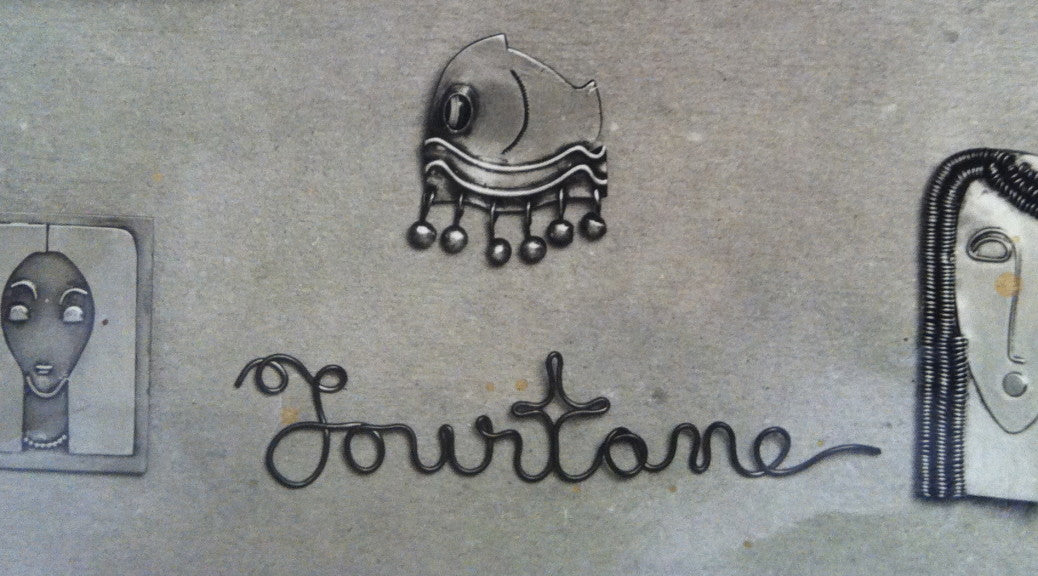As I looked closer at the piece, I could make out some other words: SS, Fourtane, Loyola. Thinking the SS stood for “Sterling Silver”, I ignored it. The mystery was solved when I discovered that Ed and Loyola Fourtane, husband and wife artists and studio jewelers, lived and worked in Sausalito on a former lumber boat, the SS Lassen, from the mid-1930’s until the 1950’s.
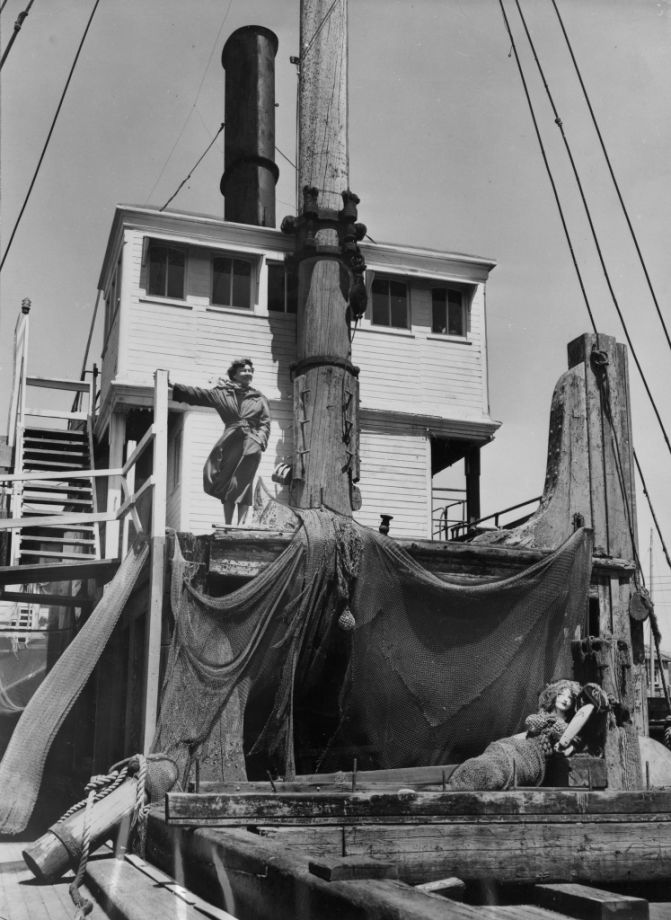 Loyola Fourtane on the bridge of the Lassen. Photographer: Bob Campbell, The Chronicle
Loyola Fourtane on the bridge of the Lassen. Photographer: Bob Campbell, The Chronicle
Sausalito: Artists on Houseboats, 1930’s to 1950’s
Loyola and Ed Fourtane were at the center of Sausalito’s art community in the mid-20th century. The SS Lassen became “headquarters for an art community born when Ed and Loyola” acquired the ship in 1936 according to an article in the MarinScope. “They soon had other artists working aboard…like an early-day art commune”. As one former occupant said, “The Lassen became a gathering place for artists and waterfront people…very impromptu parties, everyone brought a jug”.
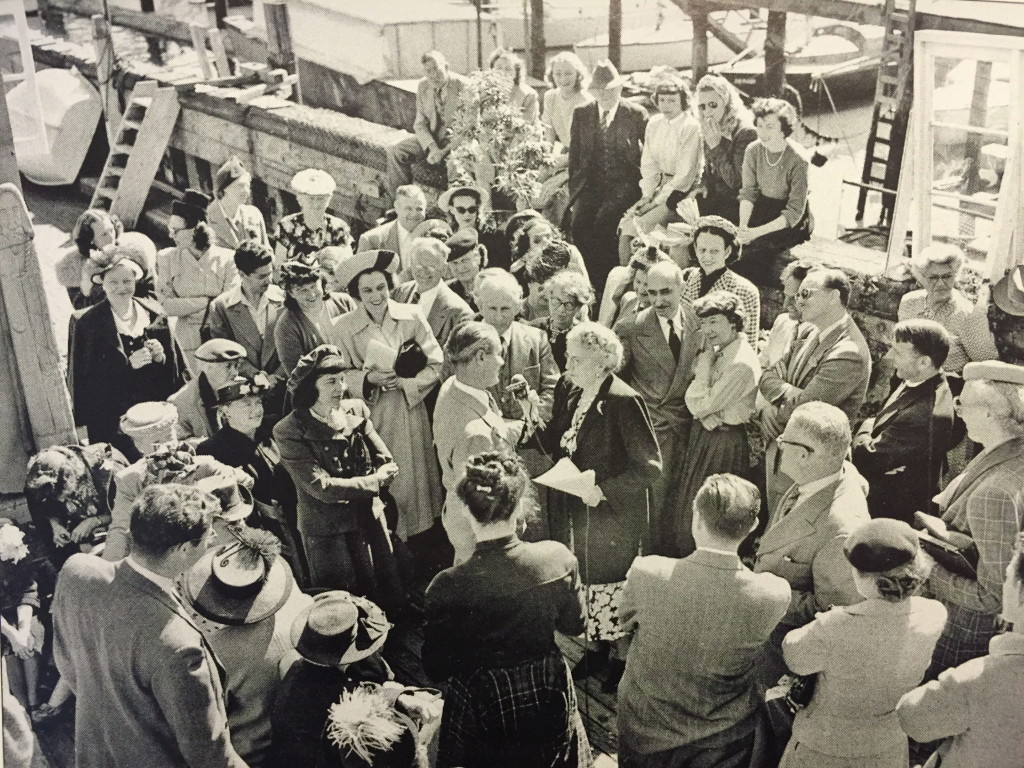 Reporter interviewing someone on the SS Lassen. Loyola is standing behind the woman with the microphone. From “Houseboats of Sausalito” (photo courtesy of Sausalito Historical Society)
Reporter interviewing someone on the SS Lassen. Loyola is standing behind the woman with the microphone. From “Houseboats of Sausalito” (photo courtesy of Sausalito Historical Society)
In The Houseboats of Sausalito author Phil Frank states that “Radio shows, parties, media events, unveilings, and award presentations were a part of the everyday scene around the old lumber schooner. When the press needed a quote or a little film footage, the Lassen became the destination.”
 Photos of SS Lassen from the Sausalito Historical Society, undated, photographers unknown
Photos of SS Lassen from the Sausalito Historical Society, undated, photographers unknown
Ed and Loyola used the pilot house as their showroom and had their studios below. Loyola’s sitting room was in the captain’s cabin and the ship contained four artists’ workshops.
 Loyola Fourtane in her studio on the SS Lassen. From “Houseboats of Sausalito” (photo courtesy of Sausalito Historical Society)
Loyola Fourtane in her studio on the SS Lassen. From “Houseboats of Sausalito” (photo courtesy of Sausalito Historical Society)
The Jewelry of Loyola Fourtane
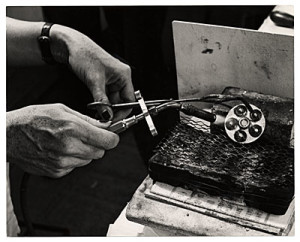 Loyola working on a piece of jewelry, Photographer: Harry Bowden, from the Archives of American Art, Smithsonian Institution
Loyola working on a piece of jewelry, Photographer: Harry Bowden, from the Archives of American Art, Smithsonian Institution
Ed and Loyola were “renowned for their exquisite jewelry” according to the MarinScope. Frank describes Loyola Fourtane as “a nationally renowned jeweler” whose “work was in great demand in museum shops around the country and in Hollywood movies”.
The Trumpeteer states “Fourtane jewelry has become famous indeed. To recite a few of their successes: The Smithsonian…purchased fifteen choice pieces. Loyola’s work was exhibited at the Metropolitan Museum…One of her necklaces was selected by Harper’s Bazaar…Furthermore Loyola designed jewelry for stage celebrities Cornel Wilde, Greer Garson and others…Loyola’s creations were shown on models of Hattie Carnegie, Nettie Rosenstein, (and) Adrian.” This article also notes that her work was being carried by Gump’s, the renowned San Francisco store.
But where is the jewelry? Despite repeated searches on the internet, only a few pieces turned up.
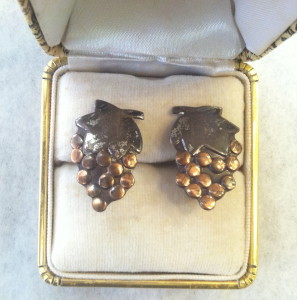 Loyola Fourtane Earrings, Collection of the Sausalito Historical Society, photo by Lisa Kramer
Loyola Fourtane Earrings, Collection of the Sausalito Historical Society, photo by Lisa Kramer
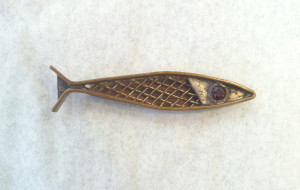 Loyola Fourtane Tie or Money Clip in the collection of the Sausalito Historical Society, photo by Lisa Kramer
Loyola Fourtane Tie or Money Clip in the collection of the Sausalito Historical Society, photo by Lisa Kramer
Luckily, the Sausalito Historical Society had two examples of Loyola Fourtane’s work, a pair of earrings and a tie or money clip, and several photos showing other, more interesting, examples. The earrings, which are in the form of grape clusters, included a note from their donor stating that they had been purchased directly from Loyola at her studio on the Lassen around 1951. According to the donor, Loyola did the designing and finishing and her husband Ed the rough work.
The Sausalito Historical Society also had a photograph showing a grouping of Loyola’s work:
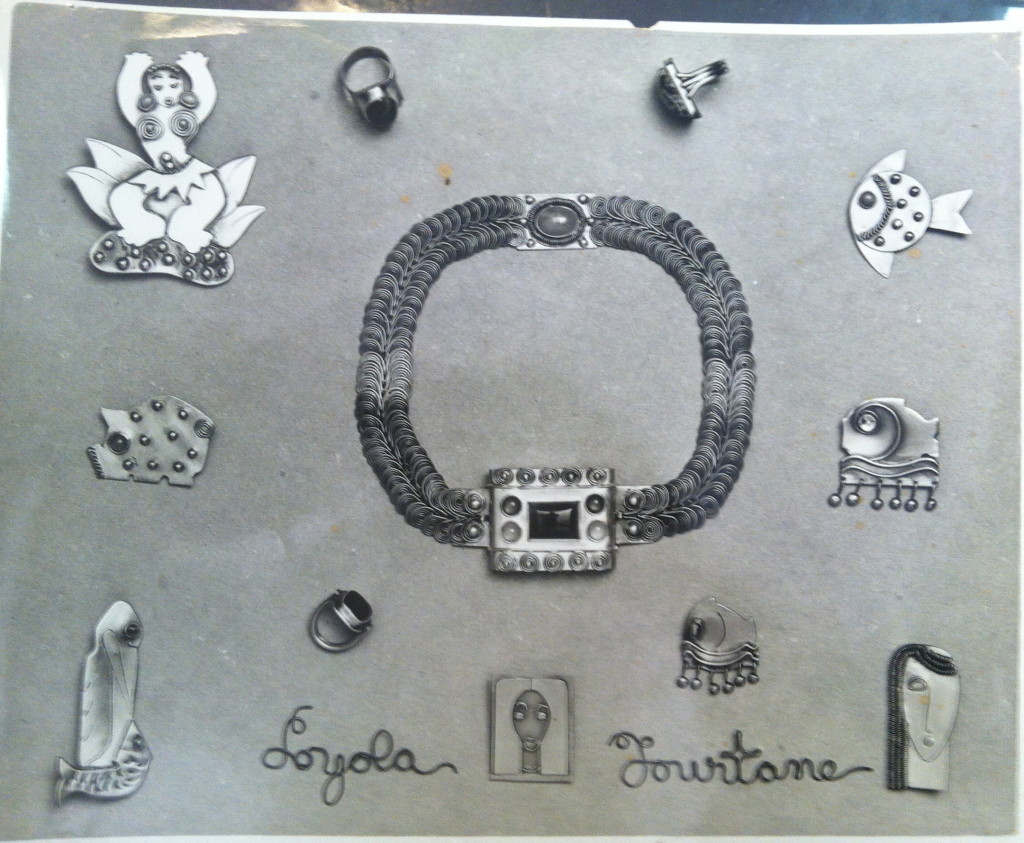 Loyola Fourtane jewelry. The necklace at the center of the photo is similar (perhaps the same?) to the one worn by Loyola in the photo of her in her studio. Photo courtesy of Sausalito Historical Society.
Loyola Fourtane jewelry. The necklace at the center of the photo is similar (perhaps the same?) to the one worn by Loyola in the photo of her in her studio. Photo courtesy of Sausalito Historical Society.
 Loyola Fourtane, Large Brooch in the shape of an eggplant, Photo by Lisa Kramer
Loyola Fourtane, Large Brooch in the shape of an eggplant, Photo by Lisa Kramer
 Loyola Fourtane Jewelry. Note how similar the brooch in the upper right (item #2) is to the eggplant brooch. Undated and unknown magazine reprint from Sausalito Historical Society
Loyola Fourtane Jewelry. Note how similar the brooch in the upper right (item #2) is to the eggplant brooch. Undated and unknown magazine reprint from Sausalito Historical Society
The piece of jewelry that started this investigation, acquired from the estate of a Bay Area artist, is a large silver brooch in the shape of an eggplant. It has flat, stylized leaves and calyx and makes stunning use of an agate with a slight lavender cast (the color does not show up well in the photo). A similar brooch described as a “gold, silver and rare chalcedony brooch of gourd design” can be seen in a magazine reprint from the Sausalito Historical Society’s archives .
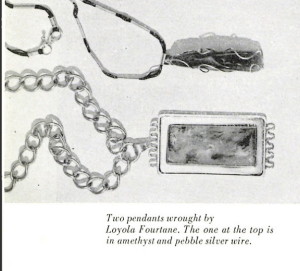 Craft Horizons, April 1952, Photographer unknown
Craft Horizons, April 1952, Photographer unknown
Two more of her pieces were featured in the April 1952 issue of Craft Horizons, the journal of the American Craft Council. In an article about an exhibition entitled “From Rock to Beauty” her work appeared alongside that of Paul Lobel and Sam Kramer, two studio jewelers who are renowned today.
At some point in the 1950’s Ed and Loyola moved to Carmel, California, at that time also an artists’ colony, and opened a successful jewelry gallery in the Pine Inn. To this day, a jewelry store called Fourtane remains at the Pine Inn, although it no longer has a connection to the Fourtane family.
 Faint Marks that started this search, photo by Lisa Kramer
Faint Marks that started this search, photo by Lisa Kramer
Loyola Fourtane died on March 31, 1976 in Pacific Grove, California and is little-known today. One reason might be because some of her jewelry was unmarked and, even when it was, her signature can be quite faint and difficult to read. Her work also varies in style, although some consistent design characteristics are apparent: the use of flattened, stylized detail in the figural pieces; and the use of unusually shaped and colored stones in both the figural pieces, like my eggplant brooch, and the pieces seen in the Craft Horizons article.
Many of the pieces also show her sense of humor, not surprising from someone whose home and studio was a gathering place for the community, where “everyone brought a jug” and you were welcomed with a sign that says “Keep Out!”
 Cartoon by artist Ray Raymond with directions on how to get to the SS Lassen: “Go thru door with sign that says KEEP OUT!”. From “Houseboats of Sausalito” (courtesy of Sausalito Historical Society)
Cartoon by artist Ray Raymond with directions on how to get to the SS Lassen: “Go thru door with sign that says KEEP OUT!”. From “Houseboats of Sausalito” (courtesy of Sausalito Historical Society)
References:
The Houseboats of Sausalito, Phil Frank, 2008, Arcadia Publishing
MarinScope, untitled article dated December 20, 1983, by Annie Sutter
The Trumpeteer, undated article reprint, by Elleanor Staschen from Sausalito Historical Society archives
Harry Bowden papers, Archives of America Art, Smithsonian Institution
“Rockhound and Jeweler”, Craft Horizons, April 1952, author unknown
Thanks to the Sausalito Historical Society for access to their Loyola Fourtane archives


